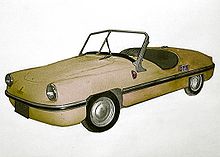This is an old revision of this page, as edited by Marlo Jonesa (talk | contribs) at 08:29, 19 January 2017 (Reverted 2 edits by 195.37.108.231 (talk) to last revision by Addbot. (TW)). The present address (URL) is a permanent link to this revision, which may differ significantly from the current revision.
Revision as of 08:29, 19 January 2017 by Marlo Jonesa (talk | contribs) (Reverted 2 edits by 195.37.108.231 (talk) to last revision by Addbot. (TW))(diff) ← Previous revision | Latest revision (diff) | Newer revision → (diff)
The Spatz (German for sparrow), later renamed the Victoria 250, is a four-wheeled microcar that was built between 1956 and 1958.
The car was originally conceived by Egon Brütsch as the Brütsch 200 "Spatz" a Fiberglass three-wheeler with the suspension of the front wheels and the rear wheel attached directly to the body shell. As such the car proved engineeringly unsound and trial runs on rough roads led to severe cracks in the bodywork.
Harald Friedrich, managing partner of Alzmetall P. Meier & Friedrich GmbH in Altenmarkt an der Alz, acquired the license from Brütsch to build the "Spatz" (German for sparrow) and in July 1956 with the Victoria works as a partner, founded the Bayerische Autowerke GmbH (BAG).
Because of the deficiencies in the original design, Frederick asked the then 77-year-old Hans Ledwinka, the former Tatra engineer, to design a robust chassis for the car. The result was a central tube frame and four wheels – in contrast to the original three-wheeled Brütsch. Frederick then saw himself no longer obligated to pay royalties to Brütsch, which led to a court case, which Frederick won. The judges recognising that the original Brütsch construction was both useless and dangerous.
The fiberglass bodywork resembled a sports car, but with only 10 hp (7 kW) was too underpowered to qualify as such, no matter how light it was. The cloth top was erected from inside the car. Reverse was, like for the Messerschmitt KR200, by running the engine backward (or by physically picking it up). The car was mechanically similar to the KR200 but with a single bench seat for two of three people sitting beside each other.
The engine size was increased from 200 to 250 cc. They were known for burning up. 1,588 were built between 1956 and 1958, 859 as "Spatz", 729 as "Victoria 250".

Manufacturer
Bayerische Autowerke GmbH (BAG), Nürnberg – Traunreut
Later: Victoria
References
- Hans-Ulrich von Mende, Matthias Dietz & Benedikt Taschen (Sep 1994), Kleinwagen, Small Cars, Petites Voitures, Taschen, ISBN 3-8228-8910-5
- Hanns Peter Rosellen: Deutsche Kleinwagen ..., Weltbild Verlag GmbH, Augsburg 1991, ISBN 3-89350-040-5
- Reinhard Lintelmann: Die Motorroller und Kleinwagen der fünfziger Jahre, 3rd edition, Verlag Walter Podszun, Brilon 1995, ISBN 3-86133-136-5